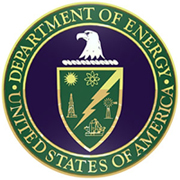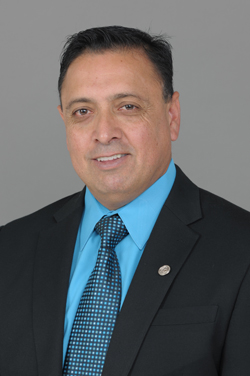DOE Fellows Amaury Betancourt, Elsa Cabrejo, Charles Castello, William Mendez, and Mario Vargas, who are all students at Florida International University (FIU), had the pleasure of meeting Ms. Yvette Collazo during her tour of the Robotics and Energetic Systems Group (RESG) facilities at Oak Ridge National Laboratory (ORNL). DOE Fellow Elsa Cabrejo participated in the full two days of Ms. Collazo’s visit to Oak Ridge since Ms. Cabrejo’s mentor, Ms. Elizabeth Phillips (DOE EM Oak Ridge), coordinated the event and escorted the visitors. During this time, Ms. Cabrejo had the opportunity to interact with Ms. Collazo as well as the other members of Ms. Collazo’s group, including Mr. Kurt Gerdes and Mr. Andrew Szilagyi. Ms. Philips discussed Ms. Cabrejo’s internship project, “In Situ Remediation and Stabilization Technologies for Mercury in Clay Soils,” with the group and explained the project’s connection with the mercury research center initiative to be developed in Oak Ridge under the supervision of the EM office.
The Robotics and Energetic Systems Group (RESG) presented the Stack Characterization System (SCS) to Ms. Collazo and her group during the visit to ORNL. The presentation included a computer-generated video explaining the deployment method of the SCS mechanism inside of a nuclear stack, as well as the main hardware and software elements of the SCS. Additional important aspects of the SCS mechanism were presented by DOE Fellows Mr. William Mendez and Mr. Mario Vargas as part of the collaboration between and technical support from the DOE Fellowship program to ORNL. During the presentation, Mr. Mendez and Mr. Vargas showed two alternative designs for the core drill mechanism to be incorporated into the SCS. These designs were developed during their Summer 2010 internship experience at ORNL under the guidance of the main mechanical designer of the RESG, Mr. Randall Lind and Mr. Peter Lloyd, Mr. Mark Noakes and Dr. François Pin.
Numerous aspects of the SCS were presented by the RESG and the DOE Fellows team from FIU. The Fellows’ participation allowed them to present the electrical and controlling elements for the SCS system specifically related to the smear sampler mechanism developed by ORNL. Ms. Collazo and her group toured several work stations where the user interface and hardware for the SCS were displayed. Another project presented to Ms. Collazo and her group was the development of prosthetic human appendages (e.g. fingers, hands, arms, etc.) with the use of 3-D printers utilizing titanium powder.
DOE Fellow and FIU student Amaury Betancourt is currently a summer intern at the Oak Ridge National Laboratory (ORNL), researching under the mentorship of Dr. Dwayne Elias. Amaury is working on understanding how the different forms of mercury affect the rates at which mercury is accumulated by sulfate-reducing bacteria (SRB) in the environment. Amaury is currently half-way through his internship and has completed an experimental plan and has tested three different media types for growing a species of SRB, Desulfovibrio desulfuricans G20. D. desulfuricans G20 is not known to form methylmercury but may still be able to accumulate mercury. The experiments will involve introducing different forms of mercury to cultures of D. desulfuricans G20 and determining the rate at which each form of mercury is accumulated by the bacteria.
DOE Fellow Charles Castello is currently interning for the summer at Oak Ridge National Laboratory (ORNL) in the Biosciences Division, Nanoscale Science and Devices Group led by Dr. Thomas G. Thundat. Charles is researching an in-situ detection methodology for Methyl-Mercury (MeHg), which involves three key steps: 1) on-line aqueous phenylation using sodium tetraphenylborate (NaBPh4); 2) preconcentration using on-line Purge-and-Trap (P&T); and 3) detection using Quartz Crystal Microbalance (QCM) sensors. This work encompasses experimentation separated into four stages where each progressive stage increases in complexity. The proof-of-concept should result in a Limit of Detection (LOD) of at least 1 part-per-billion (ppb). The purpose of this work is to aid in the understanding of methylation and de-methylation processes of Hg by providing a fast, sensitive, and reliable means of measuring MeHg in the field. Research performed in this project will be used as the basis for a PhD dissertation in Electrical Engineering at Florida International University (FIU).
By the end of the visit, Ms. Collazo and her group were evidently satisfied with the presentations and the answers to their many questions on the technical aspects of the technologies. A group photo was then taken of Ms. Collazo, Ms. Phillips, all of the DOE Fellows, the members of the RESG, and other visitors.


 I wanted to let you know about an incredible opportunity made possible to FIU minority students thanks to the sponsorship and funding of the US Department of Energy’s Office of Environmental Management (DOE-EM). In an effort to overcome the challenges of an aging workforce, DOE-EM is actively and aggressively targeting college students across the US to enter DOE’s workforce.
I wanted to let you know about an incredible opportunity made possible to FIU minority students thanks to the sponsorship and funding of the US Department of Energy’s Office of Environmental Management (DOE-EM). In an effort to overcome the challenges of an aging workforce, DOE-EM is actively and aggressively targeting college students across the US to enter DOE’s workforce.